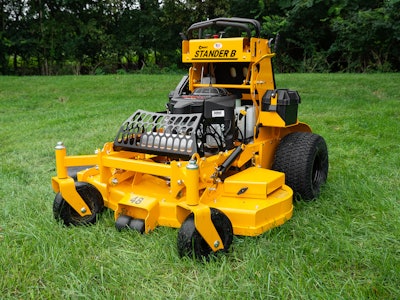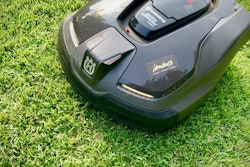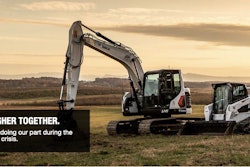 Photo: Wright Manufacturing
Photo: Wright ManufacturingBill Wright had always been a tinkerer growing up, and he had made a number of contributions to the lawn care industry before becoming the father of the stand-on mower as we know it.
He started out mowing lawns at nine years old and continued mowing on the side as he worked as a car mechanic. In his free time, he worked on improving various commercial mowers.
In 1981, he started Lawn-Wright and soon he had crews mowing 500+ lawns per week. During his time operating a landscaping company, Wright created several innovations that he decided to share with the industry.
That includes the Grass Gobbler, which was a grass catcher Wright invented after being frustrated with flimsy models that would get clogged up. He created a continuously welded, tubing frame commercial grass catcher and others wanted to buy this grass catcher as well; thus, Wright Manufacturing was born.
Another invention Wright developed with his engineer Jim Velke, was the stand-on sulky that allowed workers to ride behind their walk-behind mowers.
“At that time, the most common way to cut grass was with a walk-behind mower and number of miles walked per day was the barrier to moving the business to the next level,” says Ed Wright, CEO of Wright Manufacturing. “This was originally addressed with the Velke sulky, which allowed an operator to ride behind the mower. This reduced fatigue and allowed crews to complete more jobs per day.”
 Bill Wright
Bill WrightPhoto: Wright Manufacturing
He says that Wright Manufacturing quickly realized there was a market to sell it to other landscape companies.
Wright also created CLIP (Computerized Lawn Industry Program) Software, along with Dave Tucker, when he saw a need for software to manage billing, scheduling and routing for their lawn maintenance business.
“As the manufacturing business grew, we needed to gain focus and split up the businesses,” Ed Wright says.
After selling both the lawn maintenance business and the software company, Bill Wright was able to begin developing and field testing the concept of a stand-on mower design.
“The stand-on mower was a natural progression from the Velke sulky,” Ed Wright says. “By standing on the mower rather than behind it, the machine weight could be more central, resulting in better traction and nimbler machine.”
By 1997, the company began manufacturing the first Stander models.
“Stand-on mowers are universally appealing when you realize that more lawns can be cut in the same amount of time while also having lower operating costs, a lighter footprint, less fatigue and lower rollover hazard,” Ed Wright says.
The original stand-on mower was an upgrade from a hydro walk-behind mower, but since then these mower models are larger and offer better ground speed and horsepower. Over the years, the stand-on mower has carved out a considerable market share for itself.
Stand-on mowers offer increased productivity and allow landscapers to fit more machines on a trailer. Industry data indicates the stand-on model is the fastest growing segment and the trend is expected to continue.
“Sit-down mowers have their place in the market today, especially in very large open areas where the strategy is to cut at a lower speed with a wider deck,” Ed Wright says. “In the small and medium-sized applications, I think we will continue to see a transition to stand-on mowers.”
As more mower manufacturers develop their own stand-on mower models, Ed Wright welcomes the competition, as it drives innovation.
“In general, I don’t focus a lot of attention on our competitors because it can easily distract our team from focusing on our customers,” he says. “In order to be the most relevant provider of commercial mowers, we need to keep 100 percent focus on the safety, productivity and uptime of our customers.”
Wright says they have a strong foundation of building some of the best stand-on mowers on the market and he credits this to the relentless pursuit of making our customers’ businesses more successful.
“A huge part of this is being available to our customers and humbly taking feedback,” he says.











